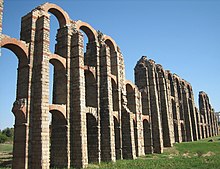Acueducto de los Milagros
| UNESCO World Heritage Site | |
|---|---|
 | |
| Criteria | Cultural: iii, iv |
| Reference | 664 |
| Inscription | 1993 (17th Session) |
The Acueducto de los Milagros ("Miraculous Aqueduct") is a ruined Roman aqueduct in Mérida, Spain, formerly the Roman colony of Emerita Augusta.
Only a relatively small stretch of the aqueduct still stands, consisting of 38 arched pillars standing 25 metres (82 ft) high along a course of some 830 metres (2,720 ft). It is constructed from opus mixtum - granite ashlar blocks interspersed with red brick - utilising a double arcade arrangement. The structure originally brought water to the city from a reservoir called the Lago de Proserpina, fed by a stream called Las Pardillas, around 5 km (3 miles) to the north-west of Mérida.[1]
It is thought to have been constructed during the 1st century AD, with a second phase of building (or renovations) around 300 AD. In later centuries, the inhabitants of Mérida dubbed it the "Miraculous Aqueduct" for the awe that it evoked.[2]
The aqueduct was one of three built at Mérida, the other two being the 15 kilometres (9.3 mi) long Aqua Augusta, fed by the Cornalvo reservoir, and San Lázaro, fed by underground channels.[3] The aqueduct is preserved as part of the Archaeological Ensemble of Mérida, a UNESCO World Heritage Site.[4]
In the immediate vicinity a small Roman bridge called Puente de Albarregas runs parallel to the arcades.
References
- ^ Roger Collins. Spain: An Oxford Archaeological Guide, p. 195, 199. Oxford University Press, 1998. ISBN 0-19-285300-7
- ^ "Study for the determination of the pathologies in the constituent materials of the Milagros Aqueduct (Mérida)", J.M. Ávila Macías, M.I. Mota López, I. Rodríguez Maribona, in Heritage, Weathering and Conservation: Proceedings of the International Heritage, Weathering and Conservation Conference (HWC-2006), 21-24 June 2006, ed. Alvarez De Buergo. Taylor & Francis, 2006. ISBN 0-415-41272-2
- ^ Leonard A. Curchin. Roman Spain: Conquest and Assimilation, p. 106. Routledge, 1991. ISBN 0-415-02365-3
- ^ "Archaeological Ensemble of Mérida". UNESCO. 2009-03-19. Retrieved 2009-03-19.
See also
![]() Media related to Acueducto de los Milagros at Wikimedia Commons
Media related to Acueducto de los Milagros at Wikimedia Commons



